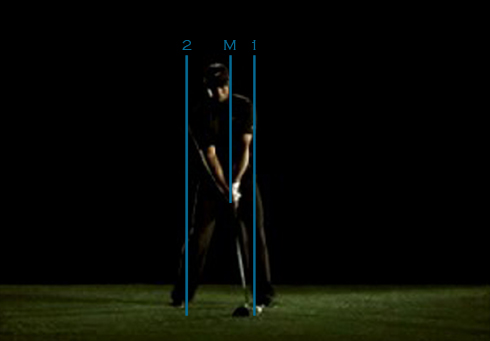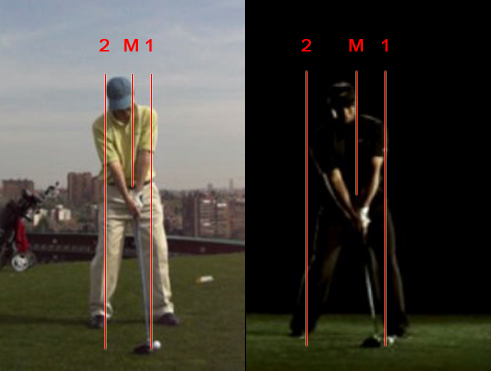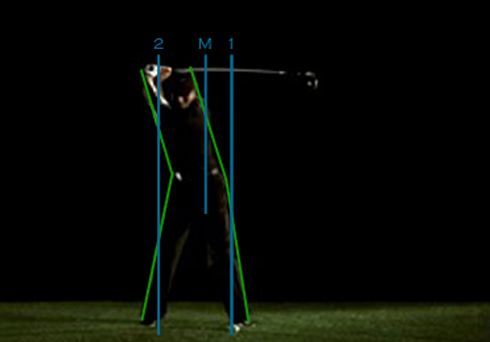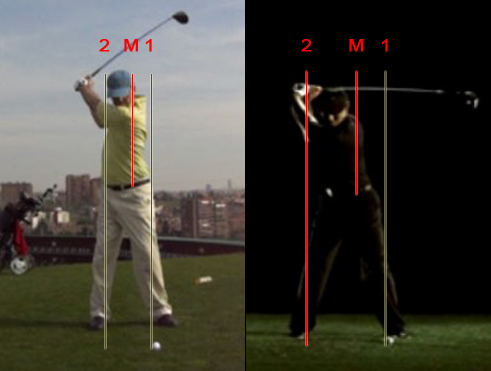 Luis Gonzalez is a 12 handicap looking to drop his score into the low 80s by the beginning of this summer. To do this he is hoping that we can help him with two main problems: consistency and power.
Luis Gonzalez is a 12 handicap looking to drop his score into the low 80s by the beginning of this summer. To do this he is hoping that we can help him with two main problems: consistency and power.
After analyzing his swing I have identified two solutions – one relatively quick and easy and the other difficult and frustrating – that should provide him with an accurate jolt of power.
Read on to see Luis’ swing and the fixes I’ve outlined for him.
The Swing
Luis Gonzalez’s swing can be seen here as a QuickTime movie. This shows two angles, at both full speed and quarter speed, both with the driver.
If you’d like to play along, look at the video and formulate your “fixes” before reading further.
Basic Analysis
When I watch Luis’s swing, I – like many of you – could probably pick out ten or fifteen different items that I would suggest changing to help him become a better golfer. My job, however, is not to give a laundry list of changes but to find a root change that may knock off several of these other problems.
In my mind, the length of Luis’s swing is not only the most obvious problem but the problem that could be affecting many other parts of his game. So analysis over: lengthen the swing.
The problem is that this type of an oversimplification of his swing that could eventually lead to more problems. To correctly lengthen his swing, create more power, and create more consistency I am suggesting that Luis both widen his stance and develop a power pivot.
Ball Position and Stance Width
When I am analyzing a swing with a face on camera angle, the first two things that I check every single time are 1) ball position and 2) stance width. Even though there is a huge debate about both ball position and stance width for iron swings, there is very little debate about either of these topics with the driver.
Most golfers believe – with plenty of physics to support them – that the ball should be played directly off of the instep of your left foot and the instep of your right foot just barely outside of your shoulders with your driver. More simply stated, your stance is shoulder width apart. Let’s start by looking at Tiger’s driver set up.

As you can see, I’ve drawn three lines – lines 1, 2, and M – for the driver setup to make this easier to visualize.
Line 1: Line 1 should run through four separate but equally important places.
- Through the back side of the ball
- Through the back side of your leading heel
- Through the front of your leading hip
- Through the front of your leading shoulder
Line 2: Line 2 should run through two separate but equally important places.
- Through the front of your trailing heel
- Through the back of your trailing shoulder
Line M: This line is a supporting line for Line 1 which crosses through two parts of your body.
- The line should start at the zipper of your pants.
- The line should end at the outside of your leading ear.
So with that these lines in mind, let’s look back at Luis’s set up and compare it to Tiger’s.

If you didn’t notice how narrow Luis’s stance width was before, then I would be willing that you do now. For Luis, Line 1 runs through the backside of the ball and the backside of his leading heel. This basically means that his ball position is correct. However, his leading hip and leading shoulder are both slightly in front of the Line 1. Although Line 2 runs through the front of his trailing heel, it is at least four to five inches inside of the back of his trailing shoulder. Anytime that you see your shoulders outside of Line 1 and Line 2, you this is an indication that your stance is not shoulder width apart.
By widening Mr. Gonzalez’s set up with his driver we are going to allow him slightly more mobility to make a full turn. Essentially, he will still be restricting the length of his swing with his core muscles but that restriction will be somewhere closer to parallel than it was before.
Power Pivot
Normally I would not recommend changing more than one thing at a time for any golfer. However, because the first change is a static fix – or a fix that is done before the player starts his swing – I am going to push just a little bit more. Our second change will be to create a power pivot.
The power pivot starts with a good strong set up but is meant to utilize the core muscles of your body to create a high torque swing. The place where this is most evident is when you complete your backswing. For the sake of simplicity, let’s use Tiger to show how this works.

Upper Body: The upper body in the power pivot actually moves towards your back foot – similar to a sway.
Lower Body: The lower body – particularly your hips – will appear to have little movement. They are moving though. Rather than sliding back with your upper body, your lower body is turning. In fact, when you first start working on this it feels like you are pushing your hips towards the target.
So now that we know what we are looking for let’s look back at Luis’s swing and compare it to Tiger’s swing.

Just with the naked eye you can tell that Tiger looks like he is in a stronger and more stable position at the top of his swing than Luis. And while stability is important, using your core muscles rather than your arms and shoulders alone will produce much more power. This is our second change we are going to make.
Potential Fixes
There are two problems that Luis is going to have to attempt to fix and because I don’t think it really fair to just say “go do it,” here are a few suggestions for what my next steps would be.
Ball Position and Stance Width
Ball position is fortunately one of those changes that requires little to no camera work to monitor. However, what it does require is a quick and easy way to make sure you are set up correctly every time. Here’s just one way.
- Measure the width of your shoulders from tip to tip with a measuring tape.
- Using your 3 wood (or any club but your driver) start at your grip and mark the same distance down on your shaft with a piece of electric tape.
- Next tome you are setting up to the ball with your driver, place your 3 wood at your feet and check to see if your stance is shoulder width apart. If it is not, adjust.
Time Line: This is a problem that can be fixed instantly but can take anywhere from a day to a month to adjust to.
Be sure to monitor: Line M. If you are standing shoulder width apart but your leading shoulder still appears to be in front of Line 1, check to see if your leading ear is behind Line M.
Power Pivot
This can be an incredibly frustrating position to learn. However, it is not impossible and with a little work on the feel of this position you should have something to take to the golf course. Here’s a quick and easy way to learn the feel of a power pivot.
- As you are setting up to the golf ball as you normally would, position a chair (or bag rack) against your leading hip.
- Slowly begin your backswing. During this motion, make sure 1) as your hips are turning they are still touching the chair and (2) your chin is moving towards your back foot.
- Hold this position between 3 and 5 seconds. As you are holding this position you should feel as if your body is wound up like a rubber band, particularly your thigh of your trailing leg as well as your back muscles.
- Repeat this motion as many times as necessary to help you learn the feel.
Time Line: Not an easy fix but some players pick this up very, very quickly. After several sessions you should start to feel more comfortable with this position but it may take several weeks before you can do it without thinking consciously about it.
Be sure to monitor: your leading shoulder. If your leading shoulder is in front of Line 1 at impact and every other part of your swing is perfect the ball will go screaming to the right. More likely, if your shoulder is in front of Line 1 at impact you are going to try to make a last minute release of the club and lose a considerable amount of power and consistency.
Conclusion
Although there are other parts of Luis’s swing that we will have to address in the future, I believe that correcting his stance width and pivot will have the greatest impact on his game. The changes I am suggesting can be very difficult. However, if you are like Luis and you are looking for more power and consistency with your driver, these are two changes I would highly recommend. Good luck.
Your Turn!
If you’re interested in having your swing analyzed in a future edition of Swing Check here on The Sand Trap, check out the requirements page and submit your videos today!

Excellent analysis-and all pretty logical. I intend to record my ‘swing’ ASAP and get it to you.
One question-if he does as you say and then starts to get other small ‘teething’ problems (this is always my experience-getting out of your comfort zone causes some problems), will you re-analyse to see what has changed and what needs to be done next?
I absolutely will re-analyze and have already been in communication with Luis. I am not really big on one and done lessons. I am always willing to check in with players I work with and help them either finish making a change or transitioning into a new one.
Oh, and what fun would it be for me if I suggested a change and then the player ran off never to be heard from again. I want to see the after as much as I want to see the before.
Hi Cocky,
this is Luis, the “star” of the swing analysis article.
i have to say that I am really happy about having provided my swing to The Sand Trap for the analysis. All I needed is a small compact digital camera; I have got a lof of feedback about what I need to do, and what I must avoid. The videos that appear in the article were recorded 10 days ago, I am making several changes to my swing, some of them have been easy, others will require a little more time to achieve. Basically I am working on:
1) My backswing path, take the club not so much to the inside.
2) Stance, shoulders width as recommedend by T.M. I think this change has not been hurtful, I can swing easily and I don’t feel rare by having a wider stance. I think this goal has been achieved very easily.
3) Backswing speed, I need to slow down my backswing, I think this will take a while, because I have had this speed for many many years.
4) Spine angle, I stand up at the end of the backswing and that doesn’t help. Need to keep my head still.
5) Knee flex, now I stand a bit more flexed. I thought this would make my swing more erratic at the beginning, but I found myself swinging the club with ease.
I have been recommended by T.M. to work on one thing at a time, two at the most. So once my stance is correct, now I am working on my backswing path and hands position (if you see my videos, you can see that right at the beginning of my backswing, my hands turn, and they musn’t).
I have the chance to write T.M. as much as I want to ask doubts I have about my swing, and have the opportunity to send more videos if desired, to see if my swing evolves fine.
I would recommend anyone who wants to have his/her swing analyzed, to send it as I did. It’s a great opportunity to see what people who know think about your swing, and how you can correct several things. And it’s not only “send and forget”, you can keep contact and get more feedback.
And hey, and you will see yourself being compared to Tiger, and that’s fun. 🙂
T.M., I am standing up in my office and working with a chair trying to feel as if my hips are almost moving forward (instead of over-turning with the rest of my body) and WOW that feels different..i can feel the torque. My swing has always had too must wrist hinge and overswing way across the line at the top. I”ve tried all sorts of wrist and arm moves in an attempt to shorten my swing but maybe it’ll be the Power Pivot that finally fixes me. I’ll be filming this tomorrow and would love for you to take a look. Thanks so much.
I will be sending my swing videos very soon.
I have always thought, and been taught, that widening the stance actually makes it harder to make a full turn, not easier. Is this a golf swing “wives tale?”
Somewhat of a wives tale. If you are using a pivot, the more narrow your stance and shorter the club, the more your swing is restricted.
If you want to see how that works, go through the exact same pivot drill above in front of a mirror. Look at your left arm and how far your club is taken back. Then to simulate that you have a shorter club in your hand, bend over slightly more and look at your left arm and the club again. You’ll see that your swing is naturally shortened. Hope that helps.
Hey T.M.,
I am about a 20 handicap and I constantly hear so called golf “gurus” always talking about
how so much of the swing is in the hips.
I guess you begin to elude to this a bit in the section of your article “Power Pivot”.
I used to be very active when I was younger and I found that as I started into my professional life, I was spending 8-10 hours per day sitting behind a desk. I’ve noticed that
my golf game has began to suffer as well.
So to make a long story short I have been doing all kinds of research and I came across this review of a hip stretching program https://top5reviewshq.com/hip-flexor-stretch/
Seeing that you guys have analyzed thousands of swings, I wanted to get your professional opinion on whether or not you think a program like that would help to improve my game and help to get my handicap heading back in the right direction.
Looking forward to your response T.M., Thanks!